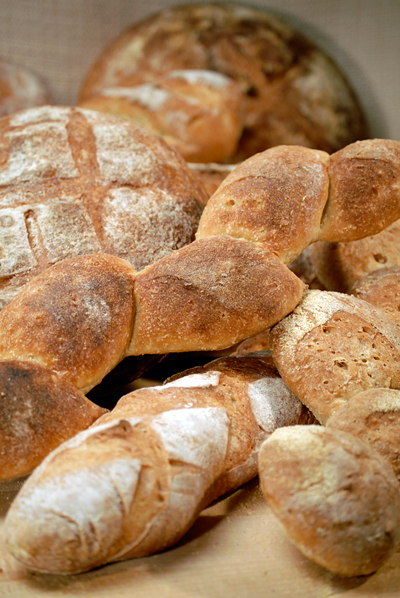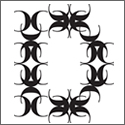Gros Pain
Episode 117: Rollin’ In Dough
Recipe: Gros Pain (Big Bread)
Gros pain, or “big bread,” was the regular daily home bread of every French family when I was a kid. It is a bit coarser in texture than a baguette and less expensive, and it keeps longer.
Makes 1 large loaf
4 1/2 cups (1 1/2 pounds) bread flour, preferably organic, plus 3 tablespoons for kneading and for sprinkling on the loaves
2 1/2 teaspoons salt
1 envelope (2 1/4 teaspoons) active dry yeast
2 cups cool water (approximately 70 degrees)
1 tablespoon cornmeal or farina
Put the 4 1/2 cups flour, the salt, yeast, and the 2 cups water in a stand mixer fitted with a dough hook or the bowl of a large food processor. If using a mixer, beat on medium speed for 2 to 3 minutes, until a smooth, elastic dough forms. If using a food processor, process the mixture for about 45 seconds on low speed if your processor has variable speeds, or for about 30 seconds if your processor has only one speed. (The temperature of the dough should not exceed 75 degrees.)
Transfer the dough to a plastic bucket (preferable) or a large deep ceramic or stainless steel bowl. Cover tightly with a lid or plastic wrap and let rise in a warm, draft-free place (about 70 degrees) for about 3 hours, until doubled in bulk.
Break down the dough by bringing the outer edges into the center and pressing down to release the air inside. Lift the dough from the bucket with one hand and sprinkle 2 tablespoons of the remaining flour into the bucket with the other. Return the dough to the bucket and knead it until the flour is incorporated and the dough is elastic, about 1 minute. Form the dough into a ball, stretching and pinching it together underneath so it is nicely rounded and taut on top.
Line a large cookie sheet with parchment paper or a nonstick baking mat and sprinkle the cornmeal on top. Place the dough seam side down on the sheet and cover it with the overturned bowl or bucket. Let rise for 2 hours, or until doubled. Alternatively, let it rise, covered, in the refrigerator overnight.
Preheat the oven to 425 degrees.
Sprinkle the top of the dough with the remaining tablespoon of flour. Cut several slits across the top of the loaf with a serrated knife. Place the loaf in the oven. Using a spray bottle filled with tap water, mist the interior of the oven a few times to create steam, then quickly close the door. After 5 minutes, mist again. Bake the loaf for 15 minutes longer, then reduce the oven temperature to 400 degrees and bake for 1 hour longer, or until brown.
Cool the bread on a rack for at least 3 hours before slicing.
Copyright © 2011 by Jacques Pépin. Used by permission of Houghton Mifflin Harcourt. All rights reserved.












I enjoyed the episode about breads. Mr. Pepin, you showed a variety of Gros Pain with wheat bran and bulgar. Are these ingredients in addition to the 4 1/2 c of flour or substituted? If substituted, how much of each are used? Thank you.
You are the best. I loved watching the bread show and have printed your recipe and vow to start making my own bread. Thank you so very much!
bread! BREAD!
We love the consistency of this bread, but when we transfer the dough to the cookie sheet after the 2nd proofing, the bread always spreads outward and becomes much flatter. We’ve done this 3 times now — making the bread stiffer and using a smaller bowl so it doesn’t “plop” so far but each time it looks more like a focaccia than a true gros pain. Anyone else have this problem? Our friend tried the recipe and had the same result. What might we be doing wrong?
in the recipe it says to knead for 1 minute. this may be too short a time depending on the strength of the flour, so you may need to knead it longer in order to activate and strengthen the gluten in the bread flour.
I had the same problem after trying 8 different kneading times. None helped. So instead of plopping the risen bread from the fridge to the baking pan to the oven, I kneaded it in the bucket for 1 minute (as you did after the first proof), THEN put it on the baking sheet, and letting it proof a third time on the sheet (covered with a box). Amazing result… finally!
I’ve been watching, and baking with your books and articles for over 30 years.
God Bless you:)
Cheers!!!
Don’t spray oven, but leave an aluminum pie plate of water on bottom rack of oven, will give all the steam needed. If loaves are too flat it is probably due to not enough flour. Try adding flour to dough is no longer sticky. Knead until dough feels like an ear lobe.
Hope helps,
Retired Foods Teacher
Made this as soon as I saw the episode about breads! THANK YOU!!! I’ve never made an easier bread and it reminds me of our travels to Europe! 2 more loaves in the oven right now!
A word of warning to anyone thinking of trying this bread: do not, DO NOT, follow the step of spraying water into the hot oven. I did, and the oven light bulb immediately exploded and sprayed shattered glass all over the place, ruining the beautiful loaf I worked so hard to achieve.
I re-checked the recipe and watched the show again but there are no warnings about this. Perhaps Jacques has a special professional oven that does not use a standard oven light bulb. Perhaps nobody on this forum actually tried this recipe, or if they did they skipped this step. Perhaps everyone but me has a special professional oven these days? Somehow I doubt it.
This experience was quite traumatic and really put me off baking bread and Mr. Pepin – which I wish had not happened. Had he mentioned this I could have avoided the problem and maybe put a tray of water in the oven instead. Really this was bad.
I am sorry to hear about what happened. It sounds like your blaming Jacques. I am sure he would have mentioned it if it had ever to him. I am sure he has made hundreds of thousands of loaves of bread and seems like a great guy, so take some responsibility that you made mistake and learn from it. I am sure were already aware of the consequences of thermally shocking certain materials like the glass on the light bulb. I have also wondered whether you had just a standard light bulb or an actual oven safe bulb. I exploded a piece of vision cookware when I placed it in the 400°F oven. I didn’t blame anyone but myself. I usually placed it in a cool oven and went from there. Anyhow, you would normally spray the sides of the oven or the bottom for a gas oven. You aren’t soaking it, you just need to mist it. I would stay away from the heating element with an electric and I would avoid spraying the fan on a convection oven.
Also, please unplug the oven when you replace the light bulb.
Dear Jacques, you are the greatest. I especially love the references to Julia and in this episode you mentioned your father kissing the bread before he threw it out(give to the dog) :-). You have taught us to live life and not just exist in it. Thank you for all your hard work, kindness and generosity.
God Bless you and your family.
-Ed
We’ve followed this recipe many times with no exploding bulbs. Our oven is the cheapest thing that you can find and far from a professional oven. Did you have an oven safe light bulb?